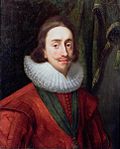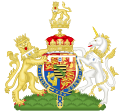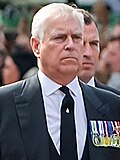Top Qs
Timeline
Chat
Perspective
Duke of York
Title of nobility From Wikipedia, the free encyclopedia
Remove ads
Duke of York is a title of nobility in the Peerage of the United Kingdom. Since the 15th century, it has, when granted, usually been given to the second son of English (later British) monarchs. The analogous title in the Scottish peerage was Duke of Albany.
Initially granted in the 14th century in the Peerage of England, the title Duke of York has been created eight times. The title Duke of York and Albany has been created three times. These occurred during the 18th century, following the 1707 unification of the Kingdom of England and Kingdom of Scotland into a single, united realm. The double naming was done so that a territorial designation from each of the previously separate realms could be included.
The title was most recently awarded by Queen Elizabeth II to her second son, the then-Prince Andrew, at the time of his wedding in 1986. In October 2025, amid controversy surrounding Andrew's ties to child sex offender Jeffrey Epstein, Buckingham Palace announced that Charles III had started a "formal process" to remove his brother's style, titles, and honours.[2] Andrew's name was removed from the Roll of the Peerage the same day.[3][4] This did not revoke his peerages,[5] but means he is no longer entitled to any place in the orders of precedence derived from them and that will cease to be addressed or referred to by any title derived from his peerages in official documents.[6]
Remove ads
History
Summarize
Perspective
In the Middle Ages, York was a main city of Northern England and remains the seat of the archbishop of York since AD 735. Yorkshire is England's largest shire in area.
York under its Viking name "Jorvik" was a petty kingdom in the Early Middle Ages. In the interval between the fall of independent Jorvik under Eric Bloodaxe, last king of Jorvik (d. 954), and the first creation of the Dukedom of York, there were a few earls of York.
The title Duke of York was first created in the Peerage of England in 1385 for Edmund of Langley. His son Edward, who inherited the title, was killed at the Battle of Agincourt in 1415. The title passed to Edward's nephew Richard, the son of Richard of Conisburgh, 3rd Earl of Cambridge (who had been executed for plotting against King Henry V). The younger Richard managed to obtain a restoration of the title, but when his eldest son, who inherited the title, became king in 1461 as Edward IV, the title merged into the Crown.
The title was next created for Richard of Shrewsbury, second son of King Edward IV. Richard was one of the Princes in the Tower, and, as he disappeared and was presumed dead without heirs, the title was considered extinct.
The third creation was for Henry Tudor, second son of King Henry VII. When his elder brother Arthur, Prince of Wales, died in 1502, Henry became heir-apparent to the throne. When Henry ultimately became King Henry VIII in 1509, his titles merged into the crown.
The title was created for the fourth time for Charles Stuart, second son of James I. When his elder brother, Henry Frederick, Prince of Wales, died in 1612, Charles became heir-apparent. He was created Prince of Wales in 1616 and eventually became Charles I in 1625 when the title again merged into the Crown.
The fifth creation was in favour of James Stuart, the second son of Charles I. New York, its capital Albany, and New York City, were named for this particular Duke of Albany and York. In 1664, Charles II of England granted American territory between the Delaware and Connecticut rivers to his younger brother James. Following its capture by the English the former Dutch territory of New Netherland and its principal port, New Amsterdam, were named the Province and City of New York in James's honour. After the founding, the Duke gave part of the colony to proprietors George Carteret and John Berkeley. Fort Orange, 150 miles (240 km) north on the Hudson River, was renamed Albany after James's Scottish title.[7][8][9] When his elder brother, King Charles II, died without heirs, James succeeded to the throne as King James II of England and King James VII of Scotland, and the title once again merged into the Crown.
During the 18th century the double dukedom of York and Albany was created a number of times in the Peerage of Great Britain. The title was first held by Duke Ernest Augustus of Brunswick-Lüneburg, Bishop of Osnabrück, the youngest brother of King George I. He died without heirs, and the title reverted to the Crown. The second creation of the double dukedom was for Prince Edward, younger brother of King George III, who also died without heirs, having never married. Again, the title reverted to the Crown. The third and last creation of the double dukedom was for Prince Frederick Augustus, the second son of King George III. He served as Commander-in-Chief of the British Army for many years, and was the original "Grand old Duke of York" in the popular rhyme. He too died without legitimate heirs, leaving the title, once again, to revert to the Crown.
The sixth creation of the Dukedom of York (without being combined with Albany) was for Prince George, second son of the, then current, Prince of Wales, the future King Edward VII. He was created Duke of York following the death of his elder brother, Prince Albert Victor, Duke of Clarence and Avondale. The title merged with the Crown when George succeeded his father as King George V.
The seventh creation was for Prince Albert, second son of King George V, and younger brother of the future King Edward VIII. Albert came unexpectedly to the throne when his brother abdicated, and took the name George VI, the Dukedom then merging into the Crown.
The title was created for the eighth time for Prince Andrew, second son of Queen Elizabeth II. As a result of his marriage to Sarah, Duchess of York, his only legitimate issue are two daughters: Princess Beatrice and Princess Eugenie. As he had no legitimate sons during his tenure, the title would have again become extinct and reverted to the Crown upon his death.
Andrew stepped back from royal duties in 2019 following an episode of the BBC's news and current affairs programme Newsnight, in which he was interviewed about his relationship with Jeffrey Epstein, the American financier and convicted sex offender.[10][11] On 17 October 2025, following discussions with the King, Andrew agreed to cease using his titles of Duke of York, Earl of Inverness and Baron Killyleagh,[12][13] although legally he still held them.[14] On 30 October 2025 Buckingham Palace issued a statement announcing that King Charles III had begun a "formal process" to remove Andrew's style, titles, and honours.[15] His name was subsequently removed from the Roll of the Peerage[16] which means the title cannot be used on official documents, though he legally remains Duke of York, Earl of Inverness, and Baron Killyleagh, because depriving a person of the peerage requires parliamentary action,[17][18] and removal of a peer's name from the Roll of the Peerage does not extinguish the peerage. The dukedom has not been returned to the Crown and if Andrew were to have a son, that son would inherit the dukedom.
Aside from the first creation, every time the Dukedom of York has been created it has had only one occupant, that person either inheriting the throne or dying without male heirs.
Pretenders
In the late 15th century, Perkin Warbeck unsuccessfully claimed the Crown by claiming the identity of Richard of Shrewsbury, 1st Duke of York.
In the early 18th century, the eldest son of the overthrown King James II & VII and thus Jacobite claimant to the throne, James Francis Edward Stuart, known to his opponents as the Old Pretender, granted the title "Duke of York" (in the Jacobite Peerage) to his own second son, Henry, using his purported authority as King James III & VIII. Henry later became a cardinal in the Catholic church and is thus known as the Cardinal Duke of York. Since James was not recognised as king by English law, the grant is also not recognised as a legitimate creation.
Remove ads
Dukes of York
Summarize
Perspective
First creation, 1385–1461
Second creation, 1474
Third creation, 1494
Fourth creation, 1605
Fifth creation, 1633/1644
James was styled Duke of York from birth and officially created as such in 1644.
Jacobite creation, 1725
Sixth creation, 1892
Seventh creation, 1920
Eighth creation, 1986
Remove ads
Family trees
Summarize
Perspective
| Peerages of Albany, Arklow, Inverness, Ulster and York family tree | |||||||||||||||||||||||||||||||||||||||||||||||||||||||||||||||||||||||||||||||||||||||||||||||||||||||||||||||||||||||||||||||||||||||||||||||||||||||||||||||||||||||||||||||||||||||||||||||||||||||||||||||||||||||||||||||||||||||||||||||||||||||||||||||||||||||||||||||||||||||||||||||||||||||||||||||||||||||||||||||||||||||||||||||||||||||||||||||||||||||||||||||||||||||||||||||||||||||||||||||||||||||||||||||||||||||||||||||||||||||||||||||||||||||||||||||||||||||||||||||||||||||||||||||||||||||||||||||||||||||||||||||||||||||||||||||||||||||||||||||||||||||||||||||||||||||||||||||||||||||||||||||||||||||||||||||||||||||||||||||||||||||||||||||||||||||||||||||||||||||||||||||||||||||||||||||||||||||||||||||||||||||||||||||||||||||||||||||||||||||||||||||||||||||||||||||||||||||||||||||||||||||||||||||||||||||||||||||||||||||||||||||||||||||||||||||||||||||||||||||||||||||||||||||||||||||||||||||||||||||||||||||||||||||||||||||||||||||||||||||||||||||||||||||||||||||||||||||||||||||
|---|---|---|---|---|---|---|---|---|---|---|---|---|---|---|---|---|---|---|---|---|---|---|---|---|---|---|---|---|---|---|---|---|---|---|---|---|---|---|---|---|---|---|---|---|---|---|---|---|---|---|---|---|---|---|---|---|---|---|---|---|---|---|---|---|---|---|---|---|---|---|---|---|---|---|---|---|---|---|---|---|---|---|---|---|---|---|---|---|---|---|---|---|---|---|---|---|---|---|---|---|---|---|---|---|---|---|---|---|---|---|---|---|---|---|---|---|---|---|---|---|---|---|---|---|---|---|---|---|---|---|---|---|---|---|---|---|---|---|---|---|---|---|---|---|---|---|---|---|---|---|---|---|---|---|---|---|---|---|---|---|---|---|---|---|---|---|---|---|---|---|---|---|---|---|---|---|---|---|---|---|---|---|---|---|---|---|---|---|---|---|---|---|---|---|---|---|---|---|---|---|---|---|---|---|---|---|---|---|---|---|---|---|---|---|---|---|---|---|---|---|---|---|---|---|---|---|---|---|---|---|---|---|---|---|---|---|---|---|---|---|---|---|---|---|---|---|---|---|---|---|---|---|---|---|---|---|---|---|---|---|---|---|---|---|---|---|---|---|---|---|---|---|---|---|---|---|---|---|---|---|---|---|---|---|---|---|---|---|---|---|---|---|---|---|---|---|---|---|---|---|---|---|---|---|---|---|---|---|---|---|---|---|---|---|---|---|---|---|---|---|---|---|---|---|---|---|---|---|---|---|---|---|---|---|---|---|---|---|---|---|---|---|---|---|---|---|---|---|---|---|---|---|---|---|---|---|---|---|---|---|---|---|---|---|---|---|---|---|---|---|---|---|---|---|---|---|---|---|---|---|---|---|---|---|---|---|---|---|---|---|---|---|---|---|---|---|---|---|---|---|---|---|---|---|---|---|---|---|---|---|---|---|---|---|---|---|---|---|---|---|---|---|---|---|---|---|---|---|---|---|---|---|---|---|---|---|---|---|---|---|---|---|---|---|---|---|---|---|---|---|---|---|---|---|---|---|---|---|---|---|---|---|---|---|---|---|---|---|---|---|---|---|---|---|---|---|---|---|---|---|---|---|---|---|---|---|---|---|---|---|---|---|---|---|---|---|---|---|---|---|---|---|---|---|---|---|---|---|---|---|---|---|---|---|---|---|---|---|---|---|---|---|---|---|---|---|---|---|---|---|---|---|---|---|---|---|---|---|---|---|---|---|---|---|---|---|---|---|---|---|---|---|---|---|---|---|---|---|---|---|---|---|---|---|---|---|---|---|---|---|---|---|---|---|---|---|---|---|---|---|---|---|---|---|---|---|---|---|---|---|---|---|---|---|---|---|---|---|---|---|---|---|---|---|---|---|---|---|---|---|---|---|---|---|---|---|---|---|---|---|---|---|---|---|---|---|---|---|---|---|---|---|---|---|---|---|---|---|---|---|---|---|---|---|---|---|---|---|---|---|---|---|---|---|---|---|---|---|---|---|---|---|---|---|---|---|---|---|---|---|---|---|---|---|---|---|---|---|---|---|---|---|---|---|---|---|---|---|---|---|---|---|---|---|---|---|---|---|---|---|---|---|---|---|---|---|---|---|---|---|---|---|---|---|---|---|---|---|---|---|---|---|---|---|---|---|---|---|---|---|---|---|---|---|---|---|---|---|---|---|---|---|---|---|---|---|---|---|---|---|---|---|---|---|---|---|---|---|---|---|---|---|---|---|---|---|---|---|---|---|---|---|---|---|---|---|---|---|---|---|---|---|---|---|---|---|---|---|---|---|---|---|---|---|---|---|---|---|---|---|---|---|---|---|---|---|---|---|---|---|---|---|---|---|---|---|---|---|---|---|---|---|---|---|---|---|---|---|---|---|---|---|---|---|---|---|---|---|---|---|---|---|---|---|---|---|---|---|---|---|---|---|---|---|---|---|---|---|---|---|---|---|---|---|---|---|---|---|---|---|---|---|---|---|---|---|---|---|---|---|---|---|---|---|---|---|---|---|---|---|---|---|---|---|---|---|---|---|---|---|---|---|---|---|---|---|---|---|---|---|---|---|---|---|---|---|---|---|---|---|---|---|---|---|---|---|---|---|---|---|---|---|---|---|---|---|---|---|---|---|---|---|---|---|---|---|---|---|---|---|---|---|---|---|---|---|---|---|---|---|---|---|---|---|---|---|---|---|---|---|---|---|---|---|---|---|---|---|---|---|---|---|---|---|---|---|---|---|---|---|---|---|---|---|---|---|---|---|---|
| |||||||||||||||||||||||||||||||||||||||||||||||||||||||||||||||||||||||||||||||||||||||||||||||||||||||||||||||||||||||||||||||||||||||||||||||||||||||||||||||||||||||||||||||||||||||||||||||||||||||||||||||||||||||||||||||||||||||||||||||||||||||||||||||||||||||||||||||||||||||||||||||||||||||||||||||||||||||||||||||||||||||||||||||||||||||||||||||||||||||||||||||||||||||||||||||||||||||||||||||||||||||||||||||||||||||||||||||||||||||||||||||||||||||||||||||||||||||||||||||||||||||||||||||||||||||||||||||||||||||||||||||||||||||||||||||||||||||||||||||||||||||||||||||||||||||||||||||||||||||||||||||||||||||||||||||||||||||||||||||||||||||||||||||||||||||||||||||||||||||||||||||||||||||||||||||||||||||||||||||||||||||||||||||||||||||||||||||||||||||||||||||||||||||||||||||||||||||||||||||||||||||||||||||||||||||||||||||||||||||||||||||||||||||||||||||||||||||||||||||||||||||||||||||||||||||||||||||||||||||||||||||||||||||||||||||||||||||||||||||||||||||||||||||||||||||||||||||||||||||
| Family tree of Royal dukes in the United Kingdom | |||||||||||||||||||||||||||||||||||||||||||||||||||||||||||||||||||||||||||||||||||||||||||||||||||||||||||||||||||||||||||||||||||||||||||||||||||||||||||||||||||||||||||||||||||||||||||||||||||||||||||||||||||||||||||||||||||||||||||||||||||||||||||||||||||||||||||||||||||||||||||||||||||||||||||||||||||||||||||||||||||||||||||||||||||||||||||||||||||||||||||||||||||||||||||||||||||||||||||||||||||||||||||||||||||||||||||||||||||||||||||||||||||||||||||||||||||||||||||||||||||||||||||||||||||||||||||||||||||||||||||||||||||||||||||||||||||||||||||||||||||||||||||||||||||||||||||||||||||||||||||||||||||||||||||||||||||||||||||||||||||||||||||||||||||||||||||||||||||||||||||||||||||||||||||||||||||||||||||||||||||||||||||||||||||||||||||||||||||||||||||||||||||||||||||||||||||||||||||||||||||||||||||||||||||||||||||||||||||||||||||||||||||||||||||||||||||||||||||||||||||||||||||||||||||||||||||||||||||||||||||||||||||||||||||||||||||||||||||||||||||||||||||||||||||||||||||||||||||||||
|---|---|---|---|---|---|---|---|---|---|---|---|---|---|---|---|---|---|---|---|---|---|---|---|---|---|---|---|---|---|---|---|---|---|---|---|---|---|---|---|---|---|---|---|---|---|---|---|---|---|---|---|---|---|---|---|---|---|---|---|---|---|---|---|---|---|---|---|---|---|---|---|---|---|---|---|---|---|---|---|---|---|---|---|---|---|---|---|---|---|---|---|---|---|---|---|---|---|---|---|---|---|---|---|---|---|---|---|---|---|---|---|---|---|---|---|---|---|---|---|---|---|---|---|---|---|---|---|---|---|---|---|---|---|---|---|---|---|---|---|---|---|---|---|---|---|---|---|---|---|---|---|---|---|---|---|---|---|---|---|---|---|---|---|---|---|---|---|---|---|---|---|---|---|---|---|---|---|---|---|---|---|---|---|---|---|---|---|---|---|---|---|---|---|---|---|---|---|---|---|---|---|---|---|---|---|---|---|---|---|---|---|---|---|---|---|---|---|---|---|---|---|---|---|---|---|---|---|---|---|---|---|---|---|---|---|---|---|---|---|---|---|---|---|---|---|---|---|---|---|---|---|---|---|---|---|---|---|---|---|---|---|---|---|---|---|---|---|---|---|---|---|---|---|---|---|---|---|---|---|---|---|---|---|---|---|---|---|---|---|---|---|---|---|---|---|---|---|---|---|---|---|---|---|---|---|---|---|---|---|---|---|---|---|---|---|---|---|---|---|---|---|---|---|---|---|---|---|---|---|---|---|---|---|---|---|---|---|---|---|---|---|---|---|---|---|---|---|---|---|---|---|---|---|---|---|---|---|---|---|---|---|---|---|---|---|---|---|---|---|---|---|---|---|---|---|---|---|---|---|---|---|---|---|---|---|---|---|---|---|---|---|---|---|---|---|---|---|---|---|---|---|---|---|---|---|---|---|---|---|---|---|---|---|---|---|---|---|---|---|---|---|---|---|---|---|---|---|---|---|---|---|---|---|---|---|---|---|---|---|---|---|---|---|---|---|---|---|---|---|---|---|---|---|---|---|---|---|---|---|---|---|---|---|---|---|---|---|---|---|---|---|---|---|---|---|---|---|---|---|---|---|---|---|---|---|---|---|---|---|---|---|---|---|---|---|---|---|---|---|---|---|---|---|---|---|---|---|---|---|---|---|---|---|---|---|---|---|---|---|---|---|---|---|---|---|---|---|---|---|---|---|---|---|---|---|---|---|---|---|---|---|---|---|---|---|---|---|---|---|---|---|---|---|---|---|---|---|---|---|---|---|---|---|---|---|---|---|---|---|---|---|---|---|---|---|---|---|---|---|---|---|---|---|---|---|---|---|---|---|---|---|---|---|---|---|---|---|---|---|---|---|---|---|---|---|---|---|---|---|---|---|---|---|---|---|---|---|---|---|---|---|---|---|---|---|---|---|---|---|---|---|---|---|---|---|---|---|---|---|---|---|---|---|---|---|---|---|---|---|---|---|---|---|---|---|---|---|---|---|---|---|---|---|---|---|---|---|---|---|---|---|---|---|---|---|---|---|---|---|---|---|---|---|---|---|---|---|---|---|---|---|---|---|---|---|---|---|---|---|---|---|---|---|---|---|---|---|---|---|---|---|---|---|---|---|---|---|---|---|---|---|---|---|---|---|---|---|---|---|---|---|---|---|---|---|---|---|---|---|---|---|---|---|---|---|---|---|---|---|---|---|---|---|---|---|---|---|---|---|---|---|---|---|---|---|---|---|---|---|---|---|---|---|---|---|---|---|---|---|---|---|---|---|---|---|---|---|---|---|---|---|---|---|---|---|---|---|---|---|---|---|---|---|---|---|---|---|---|---|---|---|---|---|---|---|---|---|---|---|---|---|---|---|---|---|---|---|---|---|---|---|---|---|---|---|---|---|---|---|---|---|---|---|---|---|---|---|---|---|---|---|---|---|---|---|---|---|---|---|---|---|---|---|---|---|---|---|---|---|---|---|---|---|---|---|---|---|---|---|---|---|---|---|---|---|---|---|---|---|---|---|---|---|---|---|---|---|---|---|---|---|---|---|---|---|---|---|---|---|---|---|---|---|---|---|---|---|---|---|---|---|---|---|---|---|---|---|---|---|---|---|---|---|---|---|---|---|---|---|---|---|---|---|---|---|---|---|---|---|---|---|---|---|---|---|---|---|---|---|---|---|---|---|---|---|---|---|---|---|---|---|---|---|---|---|---|---|---|---|---|---|---|---|---|---|---|---|---|---|---|---|---|---|---|---|---|---|---|---|
|
Includes dukes of: Albany, Albemarle, Bedford, Cambridge, Clarence, Connaught and Strathearn, Cumberland, Edinburgh, Gloucester, Gloucester and Edinburgh, Hereford, Kent, Kintyre and Lorne, Norfolk, Ross, Somerset, Sussex, Windsor, and York, but only when royally. Non-royal dukes are not included; see Royal dukedoms in the United Kingdom.
| |||||||||||||||||||||||||||||||||||||||||||||||||||||||||||||||||||||||||||||||||||||||||||||||||||||||||||||||||||||||||||||||||||||||||||||||||||||||||||||||||||||||||||||||||||||||||||||||||||||||||||||||||||||||||||||||||||||||||||||||||||||||||||||||||||||||||||||||||||||||||||||||||||||||||||||||||||||||||||||||||||||||||||||||||||||||||||||||||||||||||||||||||||||||||||||||||||||||||||||||||||||||||||||||||||||||||||||||||||||||||||||||||||||||||||||||||||||||||||||||||||||||||||||||||||||||||||||||||||||||||||||||||||||||||||||||||||||||||||||||||||||||||||||||||||||||||||||||||||||||||||||||||||||||||||||||||||||||||||||||||||||||||||||||||||||||||||||||||||||||||||||||||||||||||||||||||||||||||||||||||||||||||||||||||||||||||||||||||||||||||||||||||||||||||||||||||||||||||||||||||||||||||||||||||||||||||||||||||||||||||||||||||||||||||||||||||||||||||||||||||||||||||||||||||||||||||||||||||||||||||||||||||||||||||||||||||||||||||||||||||||||||||||||||||||||||||||||||||||||||
Remove ads
Places and things named after the dukes of York
Summarize
Perspective
Geographic features
Southern hemisphere
- Cape York Peninsula, Australia[33]
- Duke of York Island, Antarctica
- Duke of York Island, Papua New Guinea
- Duke of York Islands, Papua New Guinea
Canada
- Duke of York Archipelago, Canada
- Duke of York Bay, Canada
Political entities
Canada
- York, Upper Canada, now Toronto, Ontario[34]
- York County, New Brunswick, Canada[35]
United States
- New York, a U.S. state[36]
- New York City, the largest city in the United States.[36]
Schools
- Duke of York's Royal Military School, Dover, Kent, United Kingdom
- Duke of York School, Nairobi, Kenya, renamed Lenana School after Kenya attained independence in 1963.
Pubs
Ships
- HMS Duke of York (1763), a 4-gun cutter purchased in 1763 and sold in 1776
- HMS Duke of York (17), a King George V-class battleship launched in 1940, and broken up in 1958
- Hired armed cutter Duke of York
- Hired armed lugger Duke of York
- TSS Duke of York (1894)
- TSS Duke of York (1935)
Railways
- Duke of York was one of the GWR 3031 Class locomotives that were built for and run on the Great Western Railway between 1891 and 1915.
Military Music
There is also military march titled Duke of York which is used as an inspection piece or slow march. It is in 4/4 time, D Major with a form of AABBCCDD. Gordon Ashman in 1991 maintains that the melody was composed in 1805, soon after the Duke of York became Colonel of the Grenadier Guards, and notes it is still in use today as a regimental slow-march. James Merryweather however, researched the melody and found it was composed by John Gamidge in 1789, to be played by the York Waits.[37]
Remove ads
See also
- Duke of Albany
- Duke of York and Albany
- Earl of Inverness, a subsidiary title of the current creation
- Baron Killyleagh, a subsidiary title of the current creation
- Henry Benedict Stuart, created Duke of York in the Jacobite Peerage by his father the titular King James III in 1725. Living in Italy as a cardinal of the Catholic Church, he called himself the "Cardinal Duke of York" (or "Cardinal called Duke of York") for most of his life and was recognised as such by the Papacy, Modena, France, and Spain. He became the Jacobite pretender himself as "Henry IX" in 1788. The last surviving legitimate descendant of James II, his grandfather, he died without issue in 1807.
Remove ads
References
Sources
Wikiwand - on
Seamless Wikipedia browsing. On steroids.
Remove ads














